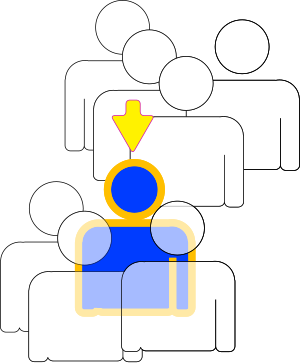Does the idea of viewpoint or point of view (POV) confuse you? Not to worry! It confuses lots of new writers, and I can remember way back 21 years ago when it kind of confused me, too.
When you’re reading a novel, think about who is telling you what’s going on.

- Image via Wikipedia
How many people are showing you the action?
- If it’s one person throughout the book, it’s a single POV.
- If it’s multiple people, then you have multiple POV.
- If it’s a third party that knows everything everyone is thinking, that’s an omniscient narrator.
I’m not even going into second person, but the only book I can think of that’s written that way is Jay McInerney’s Bright Lights, Big City. It was his first novel! But here’s an example:
” … How did you get here? It was your friend, Tad Allagash, who powered you in here. You started out on the Upper East Side with champagne and unlimited prospects, strictly observing the Allagash rule of perpetual motion: one drink per stop. Tad’s mission in life is to have more fun than anyone else in New York City, and this involves a lot of moving around, since there is always the likelihood that where you aren’t is more fun than where you are.”
The technique worked well for that book, but you can see that it’s not a viewpoint you’d want to use for kids. It’s too confusing for them.
So, if you’re just starting out or if you’re writing for small kids, it’s best to stick to a single POV. If I were to rewrite McInerney’s passage above in single POV, it would be this:
“How did I get here? It was my friend, Tad Allagash, who powered me here. I started out on the Upper East Side with champagne and unlimited prospects, strictly observing the Allagash rule of perpetual motion: one drink per stop. I’m sure that Tad’s mission in life is to have more fun than anyone else in New York City, and this involves a lot of moving around, since there is always the likelihood that where you aren’t is more fun than where you are.”
It’s all about person: I, me, mine; you, your, yours; or his, hers, its.
First person – single POV. All the action and thoughts come through the eyes of ONE character. It may or may not be your main character, too. Think Sophie’s Choice by William Styron. Though Sophie is really the main character, we see the book through the eyes of Stingo.
Third person – omniscient narrator who knows what’s happening with everyone and what everyone in the book is thinking. Many adult works are in this person.
But you have to decide what works best for your story. Besides trying different point of view studies, try giving the POV to different characters, too. You might be surprised at whose the best one to hold it!

